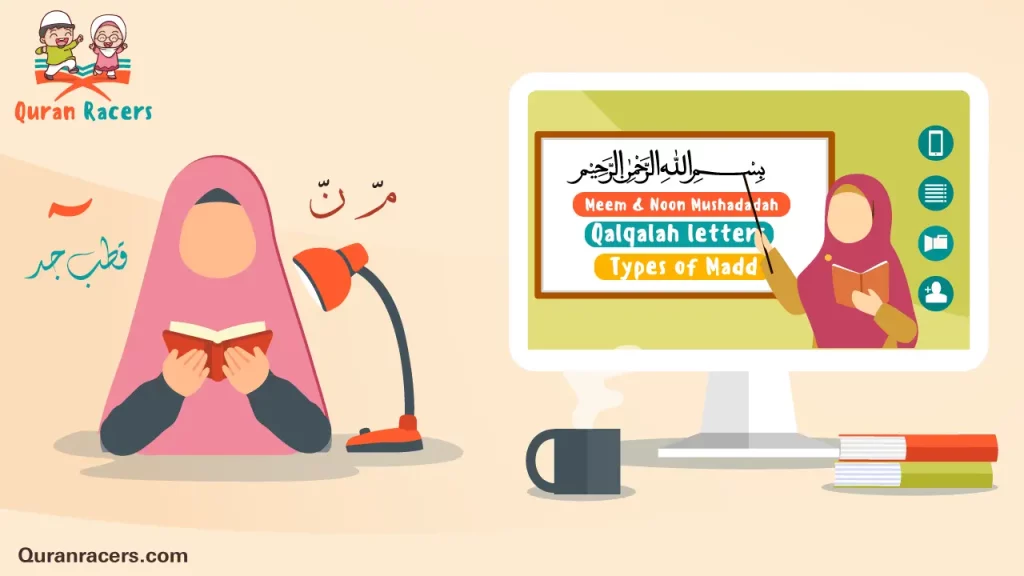Qalqalah in Tajweed
When you listen to a skilled reciter of the Quran, you may notice a gentle but distinct echoing sound on certain letters—especially when they fall at the end of an ayah. That beautiful reverberation is known as Qalqalah in Tajweed, and it’s one of the most overlooked yet powerful tools to bring clarity, precision, and strength to your recitation.
This lesson dives deep into what Qalqalah is, why it matters, and how you can master it to take your Quranic voice from ordinary to impactful. It’s not just about echo—it’s about intention, control, and honoring the divine rhythm of the Quran.
What Is Qalqalah in Tajweed ? 📘
The word Qalqalah (قلقلة) in Arabic literally means vibration or echo. In Tajweed, it refers to the slight bouncing or reverberating sound made when pronouncing certain letters that have sukoon ( ْ ) or are pronounced in a stop position. This echo ensures that these sounds are clear and don’t fade or disappear in the flow of recitation.
The letters of Qalqalah in Tajweed are:
ق – ط – ب – ج – د
(Collected in the Arabic mnemonic: قُطْبُ جَدْ)
These five letters require a slight echo when they are sakin (without a vowel) or when stopping on them at the end of a word.
Why Is Qalqalah Important ?
Without Qalqalah in Tajweed, the sound of these five letters might get lost or misheard, especially during silent stops. For example:
-
Without Qalqalah, the letter Qaaf (ق) might sound flat or incomplete.
-
With proper Qalqalah, it pops clearly, giving the recitation strength and clarity.
More than a technical rule, Qalqalah in Tajweed adds a rhythmic and assertive beauty to your reading. It brings power without harshness, and clarity without aggression.
When Does Qalqalah Apply 🎯 ?
Qalqalah happens in two main scenarios:
-
During a Stop: When any of the five Qalqalah letters fall at the end of a word and you stop on them.
-
Example: Surah Al-Masad – “لَهَبٍ وَتَبَّ”
-
The Ba (ب) at the end is echoed.
-
-
-
When the Letter Has Sukoon: Whether in the middle or end of the word.
-
Example: Surah Al-Ikhlas – “لَمْ يَلِدْ”
-
The Daal (د) is sakin and requires Qalqalah.
-
-
In both situations, the goal is to let the sound bounce slightly, not loudly. Think of it as an intentional flick, not a shout.
How to Practice Qalqalah in Tajweed?
To master Qalqalah in Tajweed, you need both your ear and your tongue to work together:
-
Echo, Not Explosion: The echo should feel like a soft bounce—not a burst. Don’t overdo it.
-
Slow Practice: Isolate words like “Iqra’”, “Abad”, “Qad”, and say them slowly, focusing on the final letter.
-
Listen & Imitate: Follow skilled reciters like Al-Husary or Al-Minshawi. Observe how they apply Qalqalah softly but clearly.
-
Record Yourself: Play it back and ask: Is the sound bouncing slightly? Or is it too flat or too harsh?
Practicing Qalqalah in Tajweed isn’t just about mechanics—it’s about training your tongue to obey the rhythm of revelation.
Quranic Examples of Qalqalah in Action 🕋
Here are some beautiful verses where Qalqalah in Tajweed is applied:
-
Surah Al-Falaq, Ayah 5
“وَمِن شَرِّ حَاسِدٍ إِذَا حَسَدَ”-
The Daal at the end of “Hasad” requires Qalqalah.
-
-
Surah Al-Ikhlas, Ayah 4
“وَلَمْ يَكُن لَّهُ كُفُوًا أَحَدٌ”-
The Daal again echoes at the stop.
-
-
Surah Al-Burooj, Ayah 10
“إِنَّ الَّذِينَ فَتَنُوا الْمُؤْمِنِينَ”-
The Qaaf and Ta sound with a firm Qalqalah in “Fata-”.
-
These echoes breathe life into your words. You’re not just reciting—you’re pronouncing revelation with power and poise.
Quick Tips for Beginners 💡
-
Practice minimal bouncing—Qalqalah in Tajweed is more subtle than many think.
-
Focus on the middle of the mouth when echoing.
-
Don’t add a vowel—just bounce the consonant.
-
Try repeating “Abad, Qad, Baq” in a loop to train.
Build Strong Recitation Habits with QuranRecers 🌱
At QuranRecers Academy, we help you go from theory to mastery. In our Tajweed modules, we offer live guidance, reciter comparison sessions, and one-on-one coaching so you can hear, feel, and speak Qalqalah in Tajweed naturally and confidently.
Whether you’re a beginner or someone revisiting Tajweed after years, QuranRecers will meet you at your level and help you grow—with clarity, confidence, and consistency.
👉 Join QuranRecers now, and let your echo be precise, beautiful, and unforgettable.
Final Reflection 💖
Reciting with Qalqalah in Tajweed isn’t just about sound—it’s about respect. It’s about giving weight to the letters that Allah chose to preserve His message. Each time you apply Qalqalah properly, you magnify the clarity of the Quran.
So let your echo carry reverence. Let your bounce reflect balance. And always remember: with every precise sound, you’re not just reading the Quran—you are reverberating divine truth.













